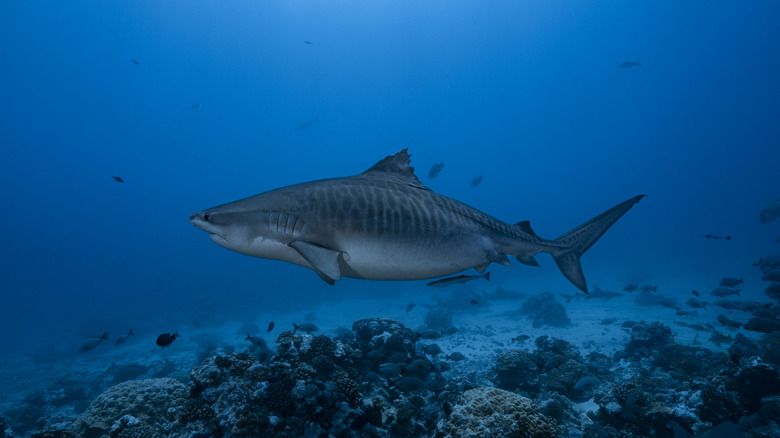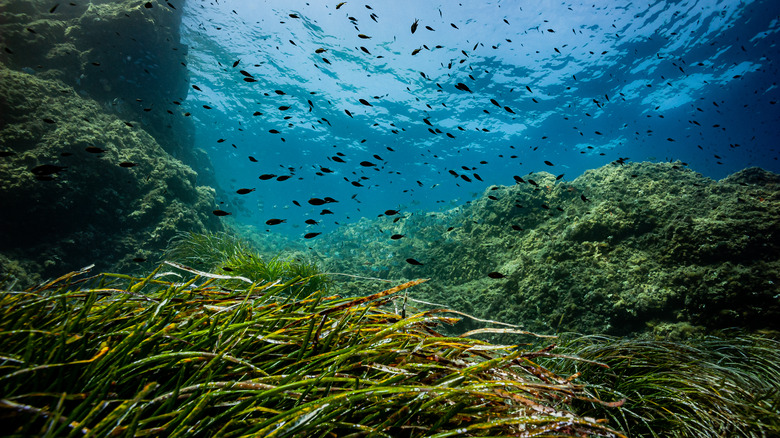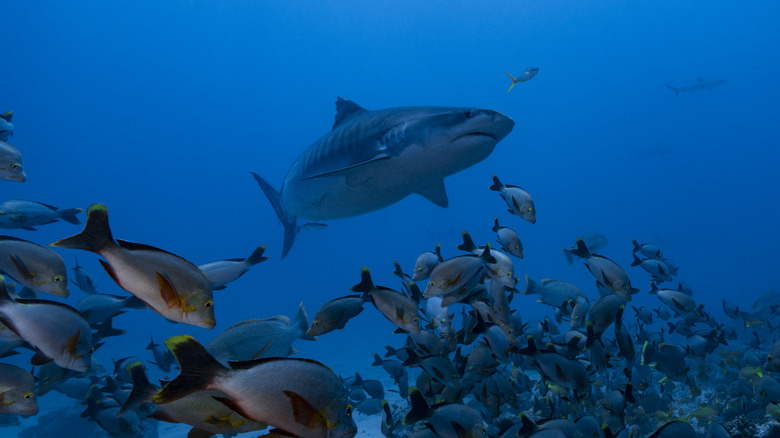Tiger Sharks Are More Important For Their Environment Than You Thought
While tiger sharks may be one of the most dangerous sharks to encounter, these predators play a surprisingly important role in their environment. This is because tiger shark eating habits play a key function in protecting local seagrass, which is an important habitat for many types of ocean life (via Smithsonian). Ironically, the tiger shark's terrifying predatory nature may actually be important for combating climate change.
The way that tiger sharks help seagrass thrive is through population control. Sea cows, also known as dugongs, are just one of the many items on the tiger shark's menu. These giant mammals are able to eat an average of 88 pounds of seagrass per day (via BBC). This can add up, decimating local seagrass beds if sea cow populations are not kept in check. Tiger sharks help to promote sea grass regrowth by hunting and scaring off sea cows, preventing them from destroying entire swaths of seagrass (via Earth Sky). This has actually helped repopulate many species that use the seagrass for protection.
Seagrass is an important part of ocean environments
Seagrass serves a vital function for many ocean animals. This is because it is able to modify the environment it is grown in, creating habitats for a variety of sea life. Seagrass does this in several ways. First, it provides a physical environment for young developing creatures like fish, shrimp, and crab to hide (via CNN). According to Smithsonian, seagrass also provides ample oxygen and food to marine life living in and around it.
Another important job of seagrass is storing high levels of carbon. This type of carbon storing is known as blue carbon, which is carbon stored in ocean and coastal ecosystems, according to the National Ocean and Atmospheric Administration (NOAA). The ability to trap carbon and store it as blue carbon is important for offsetting greenhouse emissions and climate change (via Earth Sky). The role seagrass plays in our environment is nothing to scoff at either. The Blue Carbon Initiative states, "83% of the global carbon cycle is circulated through the ocean."
Tiger shark populations are on the decline
While tiger sharks are an important part of the ecosystem, they are unfortunately on the decline. According to the IUCN Red List, tiger sharks are near threatened, with the global population decreasing. A study published in Science Direct found a 71% decrease in tiger shark populations over three generations. The trend of declining tiger shark populations also means a decrease in the amount of seagrass in their environments.
A study published in Nature found that overgrazing of herbivores like sea cows and turtles has led to a 90-100% loss of seagrass in some areas. The study noted that predators play an important role in keeping overgrazing in check by reducing herbivore populations to reasonable levels. In fact, some research shows that even just the presence of the sharks is enough, even when they aren't actively hunting. According to Florida International University marine scientist Michael Heithaus, "just the fear of sharks can be enough, in many cases, to keep a marine ecosystem healthy and able to respond to stresses" (via Earth Sky). In a news release, the National Science Foundation announced that the tiger sharks made a notable difference in the recovery of seagrass beds. Protecting tiger shark populations is an important part of ensuring the overall ecosystem remains in check, as well as helping us combat climate change head on.


